 |
こんにちは。セインさん。今日は「竺仙」にお連れします。天保13年(1842)創業の、日本一の浴衣と江戸小紋のお店です。この間は展示会にもご一緒しましたが、いかがでしたか?
Hello Thayne-san. I’ll be showing you around Chikusen today. It was established in 1842, and is considered one of the foremost makers of yukata and the Edo komon (traditional Tokyo pattern). How was the exhibition the other day? |
|
|
 |
江戸小紋の工程の一部が見られたのが良かった。感動しました。
It was great to see part of the process for making Edo komon kimono cloth. I was very impressed. |
|
|
 |
文久小紋は、複雑な柄を染めるために、一つの柄を分解して2枚の型に彫り分けるんですが、職人さんの技がすばらしかったですね。和紙の上を小刀が動いていって、細い線や複雑な曲線が彫り抜かれていくのを、私も息をつめて見ちゃいました。
In order to dye something with the detailed Bunkyu komon-type pattern, the design itself is divided into two parts and then two separate stencils have to be hand carved for each part, requiring amazing patience and technique. Watching his knife move over the surface of the paper and carving all those tiny and complex lines almost makes you forget to breathe! |
|
|
 |
職人さんに「こんなに集中してやっても、ひと月以上もかかるお仕事で、最後の最後に失敗したら悔しいですね」と聞いたら、「失敗しません」と言われちゃいました(笑)。
When I said to the artisans that it must be agonizing to work on a pattern for over a month, and then make a fatal mistake, he replied with a smile, “We don’t make mistakes.” (laughing) |
|
|
|
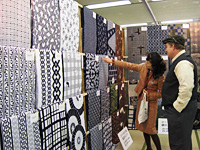 |
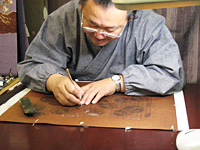 |
|
展示会で柄の説明を受けるセインさん |
小刀一つで、細かな柄が掘り出されていく!
Carving out fine patterns with a knife! |
|
|
 |
プロですからッ!(笑)でも、私も静寂な作業場で仕事をしているのかうかがったら、「いつも落語を聴きながらやっているよ…」とおっしゃってビックリしました。
この彫りの作業のあとの、2つの型を寸分違わず重ね合わせて染めていく工程も圧巻でしたね。
He’s a pro, of course! When I asked if he always works in silence, I was surprised to hear him say that he always listens to recordings of traditional comedians (rakugo).
After the two stencils are finally finished, they are placed one on top of the other―quite a process itself. |
|
|
 |
1枚の反物は、小さな型を何度も置いては染めるというのを繰り返して作っているのに、境目がわからないのに驚きました。
One of the stencils is positioned on the long roll of kimono cloth, and dye is applied. The stencil is then shifted to the next section and the process is repeated until the entire strip is covered. Each blog is perfectly matched for a continuous pattern without a single break. |
|
|
| (小川) |
やあ、セインさん、こんにちは。「竺仙」の小川です。展示会にも足を運んでくださってありがとうございます。江戸小紋も浴衣も、日本の手仕事、江戸の技で作られているんですよ。
セインさんは、たとえばどんな柄がお好きですか?
Thayne-san. Hello, I’m Ogawa. Thank you for coming to the exhibition. …Both Edo komon and yukata are made by Japanese handwork and are techniques from the Edo Period (1603 to 1868).
What type of pattern do you like, Thayne-san? |
|
|
|
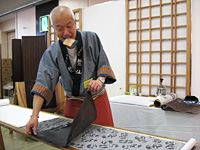 |
2枚の型がぴったり合って、一つの柄に。さらに、それを繰り返して1枚の反物が出来上がる。
The same process is repeated with the other stencil, making sure the two overlapping patterns match perfectly. |
|
|
 |
たとえば、女性用だったら、こんな柄かな。うわ~、きれい!
モチーフは小川さんが考えられたものですか?
Well, a woman might like this kind of pattern. Wow! Beautiful! Were you the one who thought of this motif, Ogawa-san? |
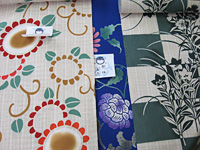 |
|
|
| (小川) |
いえ、こうした浴衣の柄は、どれも江戸から伝わっているモチーフなんです。ただし、昔と今とではモチーフの使い方が違います。
江戸時代の浴衣の柄は、細かくて、凝ったモチーフを一つの浴衣のなかにいくつも組み合わせて使うのが一般的だったんです。でも、その良さがわかる人が少なくなってきた。それで、モチーフをひとつ一つにバラしてシンプルに使う方が、現代人にわかりやすいし、また現代という時代の好みにも合うと考えたんです。
No, the patterns on yukata such as these are passed down from the Edo Period. But the way we use the patterns today differs from the old tradition.
Edo Period yukata usually had several combined elaborate patterns in one garment. The number of people today who understand such beauty has dwindled. So separating patterns into parts and using them in a simple way makes the motif much easier for modern day people to understand. It suits the tastes of modern people. |
|
|
 |
つまり、それは現代のご主人である小川さんが、江戸から伝えられてきた柄をアレンジしているということですか?
So you rearrange the patterns passed down from your ancestors from the Edo Period? |
|
|
| (小川) |
そうです。セインさん、ちょっとこれを見てください。
20年前に作ったファッション・ポートレートなんですが、着物離れが始まった時代で、若い人たちが昔ながらの浴衣を着なくなってきたんです。それで、あれこれ模索したんですが、「日本人なんだから、黙っていてもそのうちわかるだろう」という考え方をやめて、「現代人は外国人と一緒。浴衣自体にも新たな発想が必要だし、伝え方も昔のままではいけない」と思い立って、作ることを決心したんです。そうして声をかけていったら、超一流の人たちが面白がって集まってきて、すごいものができちゃった!
That’s right. Take a look at this, Thayne-san.
These are fashion photos from 20 years ago, when people, especially the young, were beginning to forget about traditional yukata. I played around with different ideas, and I decided to stop waiting and hoping that people would someday come back and start appreciating yukata again. I realized that young Japanese are the same as non-Japanese. New yukata concepts were needed and the way we explained yukata also had to change. I decided to do something and when I started talking about what I was doing, people of power and influence got interested, and it ended up changing the direction of the yukata industry! |
|
|
|
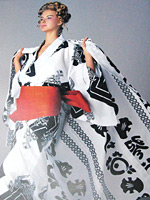 |
1991年に制作したファッション・ポートレート。
カメラマン・横須賀功光 ヘアメイク・渡辺サブロオなど、豪華な顔ぶれのスタッフ陣に驚かされる。
A fashion photo from 1991, created by top-class artists in the fashion industry. The photographer was Noriaki Yokosuka and the stylist was done by Saburo Watanabe. I was surprised by the class of people who wanted to work with us. |
|
|
 |
すごい斬新なポスターですね。20年も前のものとは思えないです。すばらしい!
A mazing! They’re so unconventional. It’s hard to imagine that they’re from 20 years ago–innovative! |
|
|
| (小川) |
浴衣の柄も、どれもモダンでしょう? 無駄がなくて、すっきりしていて、いいでしょう?
でも、これも江戸の昔からあるモチーフなんですよ。
The yukata patterns are modern, as you can see. Nothing’s wasted and it has a refreshing feeling. Nice, isn’t it? But this pattern has been around since the Edo Period. |
|
|
 |
江戸から続いてる店だからといって、古いものを守り続けているんじゃないんですね。
So, you’ve been around since the Edo Period, but your focus isn’t just on preserving the past? |
|
|
| (小川) |
そうです。実は、古い店というのは、いつも新しいことを考えているんですよ。そうでないと何百年も続かない。ただし、あまり先に行き過ぎてもいけないんで、一般の方々の1.5倍くらい先を見ている……という感じかな。
That’s right. An old company is one that is always thinking of new things. If it doesn’t, it wouldn’t survive for hundreds of years. Even so, we can’t go too far ahead. We have to look “one and a half steps” into the future. |
|
|
 |
生き残るために、昔からのモチーフを現代風にアレンジしているなんて、本当にびっくりしました。
I’m surprised that you can take traditional patterns and rearrange them in modern ways to survive into the future. |
|
|
| (小川) |
たえず革新を続けることで、店が続いてきたんですよ。
We’ve survived by always innovating. |
|
|
 |
なるほど!すごい。ところで、僕だったら、どんな柄が似合うんでしょう。
I see! That’s impressive! By the way, what kind of pattern do you think might suit me? |
|
|
| (小川) |
セインさん、柄だけで考えてはだめですよ。
日本の着物は、西洋の服とちがって、形は一つですよね?太い人も細い人も、背の高い人も低い人も、同じ反物を直線裁ちして、縫い合わせて作る、同じ形の衣類です。つまり、形は同じだから、あとは色柄で決めるものだと思われがちなんですが、そうじゃないんです。
実は、着物は、身にまとうと人によって違う形になるでしょう? たとえば、太い人が着ると布がパンッと張るけれど、細い人が着ると皺が多く出る、というように。2次元の布を体に巻きつけるんだから、誰もがそれぞれに合わない部分が出てくるんです。着物は、その合わない部分が美しいんです。
それに着方によっても優雅になったり、お転婆な感じになったり、雰囲気が変わるんです。まあ、基本的な着方がわかっていないと、サマにはならないですが。
Thayne-san, you mustn’t think only about patterns.
“Form” is one way that Japanese and Western clothing are different. Whether you’re heavy, skinny, tall or short, everyone’s yukata comes from a length of cloth sewn together. All yukata have the same form. Since the form is the same, the focus is on the pattern, right?
Actually, a kimono changes form depending on the wearer. A heavy person will pull the material tight, but on a skinnier person, the yukata will have creases and folds. With a two-dimensional cloth, no one gets a perfect fit, and that’s what makes the yukata beautiful.
The way you wear the yukata will also change the appearance–everything from elegant to tomboyish. But if you don’t know the basics of wearing a kimono, then something will look odd. |
|
|
 |
そして、その合わない部分が「個性」にもなるんですね。
The ill-fit forms your individuality. |
|
|
 |
合わない部分が、重要!哲学的ですね(笑)。それは洋服にはない考え方ですね。皺が個性になったり、着方でもイメージが変わるんだ。面白い!
The part that doesn’t fit is essential!? It’s all very philosophical. (laughing) With Western clothing, we don’t think that way. Creases becoming individuality… your image changing with the way you wear it… I find that intriguing! |
|
|
| (小川) |
じゃあ、話はここまで。
実際に反物を手にとったり、合わせてみたりしてみませんか?
肌の色や髪の色によっても、雰囲気が変わりますよ。
Well, I guess that’s about all I have to say. How about actually touching and matching the cloth? The way it looks changes with your skin and hair color. |
|
|
 |
では、僕の教室のマネージャーの女性をモデルにして…。
Oh!ビューティフル!なるほどこうやって実際に合わせてみると、どれが似合うのか、よくわかりますね。
どちらもすてきだけど、向かって左側の方が似合いますよね?
Sure! Let’s let the manager of my school, Sato-san, be the model. Oh, that’s beautiful! I get it now. When you put it on, you can really see what fits.
They’re both nice yukata, but the one on the left suits her better, doesn’t it? |
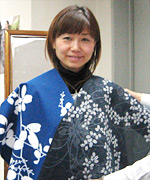 |
|
|
| (小川) |
そう、彼女のかわいらしさが際立つでしょ。
Right, it brings out her charm.
浴衣はリサイクルもできるんですよ。最初は浴衣でしょ。布がくたびれてきた寝巻き。それも着れなくなってきたら、縫い糸をほどけば平らな布になるから、適当な長さに切って赤ちゃんのおしめ。そして最後は雑巾。
You know, the yukata has many lives. It starts out as a yukata. When it becomes worn, it’s used as a night robe. From there it becomes cloth for use around the house, then baby diapers and finally, cleaning rags. |
|
|
|
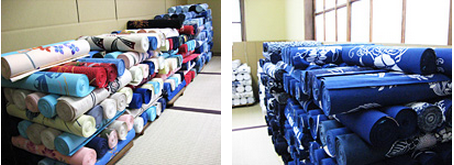 |
|
|
 |
すごい!! 洋服は、ただ捨てるしかないのに!(ものすごく驚く)
That’s great! All we do with Western clothes is throw them out! |
|
|
  |
今日は勉強になりました。小川さん、ありがとうございました。
We really learned a lot today. Thank you for your time, Ogawa-san! |
|
|
|
(文)太田美代
(英訳)デイビッド・A・セイン |
 1959年、米国生まれ。証券会社勤務を経て来日し、翻訳・通訳など多岐にわたって活躍。豊富な教授経験を生かし、数多くの英語関係書籍を執筆。近著に『日本人のチョットへんな英語』(アスコム)、『超入門シャドーイング』(主婦の友社)、日本人が使いすぎる英語(PHP文庫)など多数。
1959年、米国生まれ。証券会社勤務を経て来日し、翻訳・通訳など多岐にわたって活躍。豊富な教授経験を生かし、数多くの英語関係書籍を執筆。近著に『日本人のチョットへんな英語』(アスコム)、『超入門シャドーイング』(主婦の友社)、日本人が使いすぎる英語(PHP文庫)など多数。













